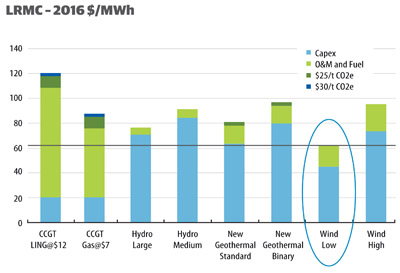 |
| Reviews and Templates for Expression We |
Wind Energy 2030
More wind powered generation in New Zealand, producing 20% of our electricity
There will be a 6-fold increase of wind generation in New Zealand, producing 20% of the country’s electricity by 2030. This is a big increase on the 5% of electricity generated by wind in 2012.
A report ‘Wind Energy 2030: the growing role for Wind Energy in New Zealand’s electricity system’, looks at the relative costs of all major forms of electricity generation and potential for future growth. It comes to the conclusion that, while all forms of renewable generation will grow to meet increasing demand, wind energy is poised for the biggest increase.
Key facts:
- Electricity demand will increase 21% by 2030 – more generation will be needed
- More wind needed to reach the Government’s target of 90% renewable electricity by 2025, up from 75% currently
- Wind will supply 20% of NZ’s electricity by 2030
- Wind capacity will be 3,500MW, up from 622MW
- At 3,500MW, wind farms will cover 0.4% of New Zealand mostly sharing that land area with traditional farming. Turbines, roads and electricity infrastructure associated with wind farms will occupy just 0.003%
- More wind capacity will be built because it is the most cost effective form of electricity generation. Investing in the most cost effective generation is the best way to limit the cost of consumers’ power bills
- The wind industry will create 1,500 jobs by 2030, many in rural areas
- Wind farm leasing will be a helpful form of revenue for many farmers - delivering over $10 million in annual lease payments by 2030
- Developing the country’s wind resources could increase export earnings
- Wind energy helps prevent fuel price shocks and provides predictable long term electricity costs
- Wind energy is very predictable, dependable on a seasonal basis and the cost of the fuel is known for certain (wind is free)
The PDF report can be downloaded here and a shorter summary here.
|
Generation Capacity (GW) |
2012 |
2030 |
|
Hydro |
5.2 |
5.4 |
|
Geothermal |
0.7 |
1.2 |
|
Wind |
0.6 |
3.5 |
|
Gas |
1.4 |
2.3 |
|
Coal |
1.0 |
0.25 |
|
Other |
? |
? |
“We live in a lucky country with an exceptional wind resource,” says Eric Pyle. “Experienced developers are already seeing wind as the most cost effective way of generating electricity and our ability to deliver lower cost energy is still improving.”
The report is underpinned with careful analysis of electricity demand and the way New Zealand’s integrated electricity system can meet that in the future.
“We have looked carefully at the Ministry of Economic Development’s energy modelling, the availability of new generation sources and the economics of different generation options,” comments Eric Pyle.
“The report estimates that wind will grow to a capacity of at least 3,500 MW from 622 MW today and make a substantial contribution to meeting the government’s target of 90% renewable generation,” he says.
“We believe that 20% by 2030 is realistic and achievable, in fact it is likely that New Zealand will have more than 20%.”
By 2016 NZWEA estimates that wind generation will be clearly the most cost-effective form of new generation. “The technology is continuing to improve,” says Eric Pyle. “Turbines are getting more reliable, operations and maintenance costs are reducing. And the industry is getting better at developing wind farms. Wind generation in New Zealand is already financially viable and it is going to get even better.”
“Once electricity demand starts to increase I am convinced that wind generation will be a high priority for all generators.”
“We do have challenges for the wind energy industry. The outdated perception of wind as expensive and unreliable remains in the minds of some people. And as a consequence the benefits of wind generation for New Zealand tend to be underplayed.”
“By producing low cost electricity wind brings benefits to the New Zealand economy and household bills, it brings jobs and earnings to rural communities and provides opportunities to export our skills,” concludes Eric Pyle.

|
|
|
|
Copyright 2011 Energy and Technical Services Ltd. All Rights Reserved. Energyts.com |